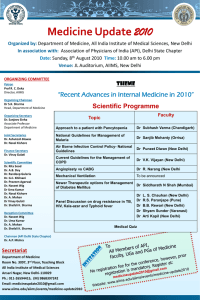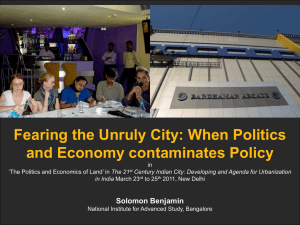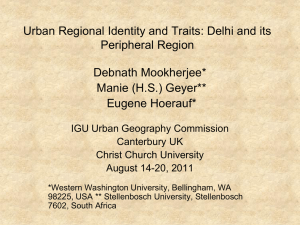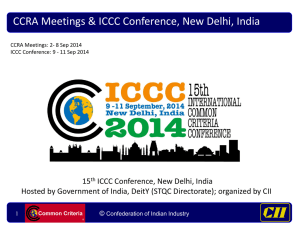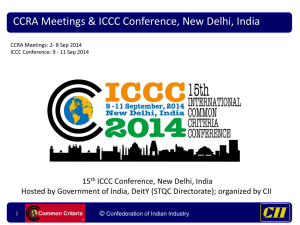Colonialism and the City
advertisement
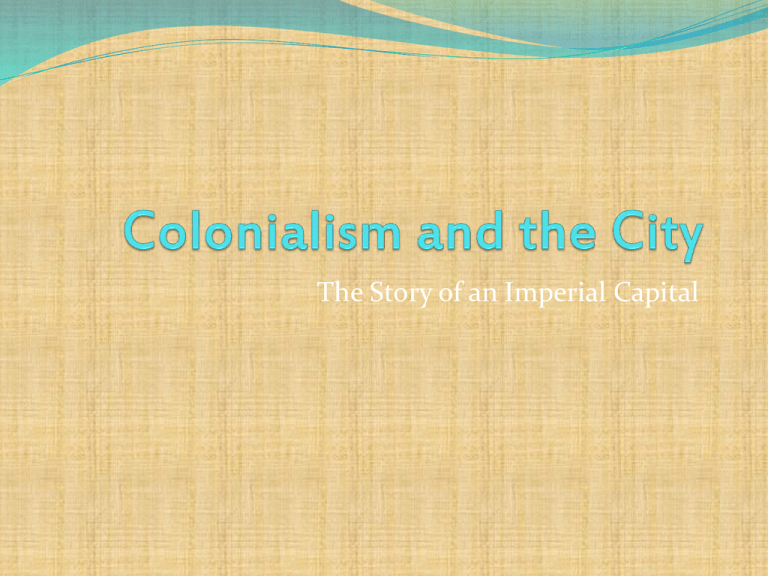
The Story of an Imperial Capital Before the Arrival of British Before the British arrived in India, there were different types of cities in India. Some were temple towns like Madurai, port cities like Surat and manufacturing towns like Dacca. In most parts of the Western world modern cities emerged with industrialisation. In Britain, industrial cities like Leeds and Manchester grew rapidly in the nineteenth and twentieth centuries, as more and more people sought jobs, housing and other facilities in these places. What happened to cities under colonial rule Process of Deurbanisation in India In late 18th century Calcutta ,Madras and Bombay rose in importance as presidency cities or centers of British Power. But at the same time many smaller towns and citites were disappearing due to the decrase in the demand of what they produced. Some cities lost their commercial value like Surat, Seringapatnam and even Delhi. What do you mean by Deurbanisation? De-urbanisation is term used for the cities which become less important as they loose the status which they might have enjoyed in the past. How many ‘Delhis’ before New Delhi? It is the capital of modern India and it has been the capital for more than a thousand years, but with some gaps. As many as 14 capital cities were made in the small area of about 60 square miles on the left bank of river Yamuna. The most splendid was Shahjahanbad made by Shah Jahan. Shahjahanbad- The most beautiful and historic capital made by Shah Jahan. Historic places of Delhi like Red Fort, Jama Masjid and Chandni Chowk were made during that time. Packed Mohallas, Bazars, Dargahs and Idgahs were other features of the city. Sad Story of Delhi It was not an ideal city. Luxuries and delights were enjoyed only by riches. If in one side of the city Huge mansions were there ,the other corner was crowded by mud houses of the poor. Even gender differences also existed e.g The colorful world of poetry and dance was usually enjoyed by men. The Making of New Delhi In 1803 British got control of Delhi but continued with Calcutta as the capital as The Mughal emperor was living there (Bahadur Shah Jafar).The modern city as we know it today developed only after 1911 when Delhi became the capital of British India. Unlike the other colonial cities like Madras, Bombay and Calcutta where the British lived in separate areas from the Indians, In Delhi they lived with Indian Communities. Period of Delhi renaissance The establishment of the Delhi College in 1792 led to a great intellectual development in the field of Science and Humanities, largely in Urdu language. Period from 1830-1857 is referred to as the ‘period of Delhi renaissance.’ Find the meaning of ‘Renaissance.’ Delhi after 1857 During the revolt that year rebels entered the city and persuaded Bahadur Shah to become the leader of uprising. Hence Delhi became an important centre for 1857 revolt. Bahadur Shah was sent to Burma, his courts were dismantled, gardens were closed and common people were thrown out of the city. One third of the city was demolished and canals were filled up. Prayers did not happen in Jama Masjid for five years. Delhi, the capital of British India To destroy the symbolic image of Delhi British organized spectacular events in Delhi e.g. Viceroy Lytton organized a Durbar to acknowledge Queen Victoria as the empress of India. In 1911, decision was taken to make Delhi capital of British India Two architects, Edward Lutyens and Herbert Baker were called on to design New Delhi and its buildings. New Delhi after 20 years of making In New Delhi no crowded Mohallas were there. A well planned network of roads was laid out. Delhi at the time of partition During partition a massive transfer of populations happened on both sides of new border. Number of Muslims left the city. Sikhs and Hindu refugees from Pakistan came here. Hence, population of city increased and culture changed. Large migration from Punjab changed the social milieu of Delhi. Inside the Old City Excellent system of water supply was broken down and drainage was neglected in 19th century. The system of wells(or baolis) also broke down, and channels to remove household waste (called effluents) were damaged , this was the time when pollution accelerated in the cities. As the broken down channels couldn’t serve the needs of this rapidly increasing population , finally , at the end of the 19th century Shahjahani drains were closed and a new system of open drains was introduced. When this system was overburdened , wealthier inhabitance complained about the stench from roadside privies and overflowing of open drains. But the Delhi municipal committee was unwilling to spend money on good drainage systems. At the same time, millions of rupees were being spent on the drainage systems in the New Delhi. The Decline Of Havelis… The Mughal aristocracy in the 17th and 18th century lived in grand mansions known as HAVELIS. In the middle of the 19th century a map showed hundreds of havelis with large walled compounds with mansions , courtyards and fountains. Havelis had pavilions and rooms which were meant for women of household. It also had public rooms which were meant for visitors and business , exclusively by males. Havelis began to be subdivided and sold because Mughal amirs were unable to maintain these large establishments under conditions of the British rule. Hence, Havelis were subdivided and sold. Many fell into decay and disuse. The colonial bunglows were meant for one nuclear family , it was a large single storeyed structure with pitched roof . The Municipality begins to plan Census of 1931 revealed the shocking facts that the walled city area was horribly crowded . In the walled area density of population was 90 people per acre while in New Delhi it was hardly 3 persons per acre. To improve the living conditions, Lahore Gate Scheme was planned by Herbert Baker. The idea was to draw residents away from the old city to a new type of market square. But construction remained incomplete and did not help the city to decongest, drainage was also poor till 1931. Delhi improvement trust was set up in 1936, and it built areas like Daryaganj South (place with same name still exists t0day) for wealthy Indians. Houses were grouped around parks, where privacy of each and every family member was taken care. Hence we can say, Delhi is unique in Indian History. It has its own story of ‘Rise and Fall.’ Today, it is the National Capital Territory of India. Chandichowk , Delhi
